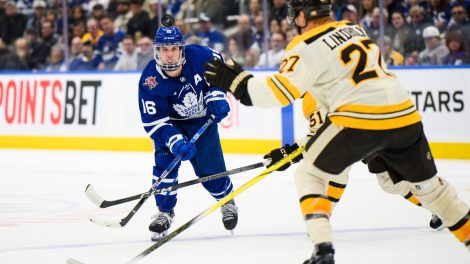NASHVILLE – It didn’t take long for the debate over whether or not fighting belongs in the NHL to reignite.
On Tuesday in Montreal, on the first night of regular season action, Canadiens enforcer George Parros fell face-first to the ice at the end of a fight with Toronto’s Colton Orr. Parros, who left the ice on a stretcher and was taken to the hospital, was diagnosed with a concussion and is out indefinitely. He was released Wednesday morning.
The fight drew the attention of people around the league, and some well-known front office executives have voiced their displeasure with fighting.
However, Nashville Predators forward Matt Hendricks had a response to the critics who sit on the opposite side of the debate.
“Fighting has a place. It’s been around as long as the goal has been around,” said Hendricks, who has dropped the gloves 43 times since arriving in the NHL in the 2008-09 season. “[Fans] love the character and competitiveness of the game and the brute force of the game. It can be very aggressive and I think the fans like seeing that.”
While Hendricks hopes nothing but the best for Parros in his recovery, the Predators’ forward said what happened Tuesday in Montreal is “a part of the game.”
“Those things happen,” he said. “Nothing there was done intentionally. I know (Colton) Orr was pulling him down protecting himself and George just seemed to go over the top of him. It was just a very unlucky play,” he said.
Parros and Orr have a reputation for simply being enforcers and nothing else.
In 453 career games, Parros has 1,027 career penalty minutes and 35 points. In 30 less games, Orr has 1,096 penalty minutes and 24 points. The prevailing thought is that players who serve the singular purpose of fighting are a dying breed, and that their role is being passed down to a player who can add a little bit more than just dropping the gloves.
Predators forward Rich Clune is among the new breed of “enforcers” who can add a physical element to the game away from fighting. Clune ranked sixth in the NHL last season with 159 hits in 47 games and chipped in offensively with nine points.
Fighting is one reason why Clune is in the NHL but it’s not the sole reason.
He engaged in 12 fights last season, his first with the Predators. For a considerable portion of the season, though, Clune was unable to fight due to stitches he had inside his mouth from one cheek to the other. While sporting a protective shield in front of his jaw, he found a way to be productive in other areas of the game.
“I’ve never been a fan of two guys on the roster that are just there to throw punches and they don’t contribute in any other aspect of the game,” Clune said. “Honestly, I think that has opened up room for a guy like me who may not be tough enough to hang with guys who are strictly fighters, but I can fight and I can play. Teams are starting to gear towards guys like that. I think it’s good for the game.”
He continued, “If they totally eliminated fighting, I think the game would change a lot. It would be a lot softer. It would basically be a special teams type game – on the perimeter, no hitting. I agree with less fights, though. I think it should be more hockey, more hitting, more battling.”
Clune doesn’t think the NHL would ever ban fighting. Why? Because it’s hockey.
“It’s a sport, man; it’s a contact sport,” he said. “If there was no fighting then a 150-pound guy who can dangle around on a shinny rink would be playing in the NHL. That’s why guys like that can’t make it — they’re not tough enough. There are guys that don’t ever fight and they’re still tough men. The game is a tough sport, through and through.
“If they took it out they’d have to change the name of hockey to something else. I don’t know if they’d be able to call it hockey anymore.”
Some hockey people believe the NHL is strategically trying to get rid of fighting gradually. Players now get a minor penalty for purposely taking off their helmets during a fight. The reason why most would do that is if one of the players involved has a visor. The next generation of NHL players will likely all be sporting visors, which could result in fighting being heavily reduced over time.
“The one thing you’ll see if there isn’t any fighting – and I’ve played in leagues where it’s been a little bit banned is the stickwork becomes very, very evident, to a point where it’s actually dangerous out there,” Predators head coach Barry Trotz said. “I think you’re going to see less of the pure tough guy who can’t play; you’re going to see more of the hard-nosed guys who can bump and grind.
“A number of years from now [fighting] will be very limited.”
Hendricks added, “This game needs its policemen on the ice and the game needs to police itself. Officials can’t always control it. It would be a shame if fighting was to leave the game altogether.”










